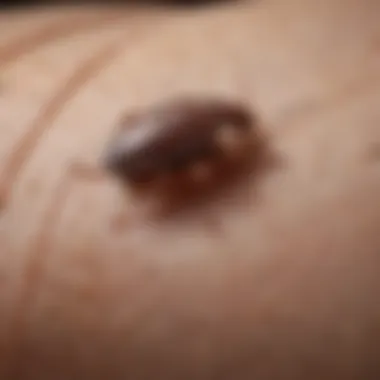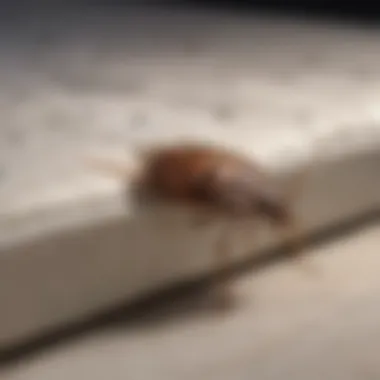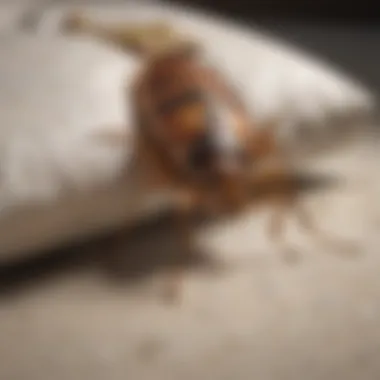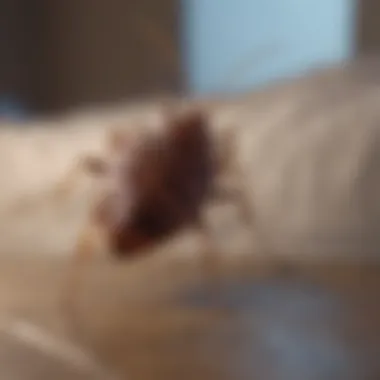Understanding Bed Bug Infection Symptoms


Intro
Bed bugs are small, elusive pests that can undermine peace in your home. Understanding the symptoms associated with bed bug infections is essential for swift identification and management. This guide aims to clarify what these symptoms are and how they manifest in both physical and behavioral aspects. It is crucial to recognize these signs for effective pest management, which addresses both personal and public health concerns.
Understanding Pests
Definition of Pests
Pests are organisms that can cause harm or annoyance to humans, pets, or the environment. Bed bugs, specifically Cimex lectularius, are classified as pests because they feed on human blood. They thrive in small crevices, often hiding in mattresses, bedding, and furniture. Their presence is not just a nuisance; it poses potential health risks through secondary infections and psychological stress.
Importance of Pest Identification
Identifying bed bugs correctly is essential. Misidentifying these pests can lead to ineffective treatments. Symptoms of bed bug bites often mimic those of other insect bites, making accurate identification crucial. Early detection helps in limiting their spread and implementing control measures before an infestation occurs.
Symptoms of Bed Bug Infections
Recognizing bed bug infection symptoms involves observing various indicators:
- Physical Reactions
Bite marks appear as small red welts, often grouped together. They may be itchy and can resemble bites from other insects. The difference lies in the pattern of the bites, which often align in a linear fashion on the skin. - Behavioral Signs
Anxiety over sleeping, especially in a potentially infested area, is common. Individuals may find it difficult to relax, fearing bites during the night. Higher levels of stress and sleep disruption often accompany an infestation. - Environmental Triggers
Outbreaks tend to increase in certain conditions, such as warmer climates. They can also spread in densely populated areas or through travel where infested luggage or items come into contact with clean environments.
"Bed bugs can thrive in places you least expect. Awareness is the first step to prevention."
There are different measures to counteract these pests. Homeowners should be educated on effective pest management strategies.
Prevention Techniques
Home and Garden Preventative Measures
Implementing proper home maintenance strategies is essential:
- Seal cracks and crevices around walls and floors to block entry points.
- Regularly wash and heat-dry bedding, curtains, and clothing. Heat is effective in killing bed bugs and their eggs.
- Vacuum thoroughly and dispose of the vacuum bag immediately.
Seasonal Prevention Tips
Seasonal changes bring variations in pest activity. Being proactive can minimize risks:
- During warmer months, check for signs of bed bugs when traveling or after large gatherings.
- In winter, reduce clutter where bed bugs can hide, facilitating easier inspections.
Eco-Friendly Pest Control Solutions
Overview of Sustainable Practices
Addressing pest control with eco-friendly solutions is growing in preference:
- Biological control uses natural predators to manage pest populations.
- Integrated pest management combines various strategies to minimize chemical use while effectively controlling pests.
Natural Remedies and Their Effectiveness
While some may seek natural remedies, it's essential to assess their effectiveness:
- Diatomaceous earth is often cited for its ability to dehydrate bed bugs on contact.
- Essential oils such as peppermint or tea tree may repel bed bugs, though their overall effectiveness is varied.
Foreword to Bed Bugs
Understanding the nature and behavior of bed bugs is essential for anyone hoping to manage or prevent infestations. Bed bugs are small, elusive insects that thrive in environments with human activity. Their biology, habitat preferences, and nocturnal behaviors contribute to the difficulty in detecting their presence early. This section aims to demystify bed bugs by outlining their biological characteristics and highlighting where they are commonly found. By grasping these fundamental elements, readers can better recognize the symptoms associated with infestations.


Overview of Bed Bug Biology
Bed bugs, scientifically known as Cimex lectularius, are hematophagous pests. These creatures feed exclusively on blood, typically that of humans. Adult bed bugs are approximately 4 to 5 millimeters in length, with a reddish-brown color and a flat, oval shape. They exhibit a remarkable ability to withstand starvation, thriving for several months without a food source. Understanding their life cycle is also crucial, as it includes multiple stages: eggs, nymphs, and adults. Each stage has distinct characteristics and requires precise conditions for survival and reproduction. The female bed bug can lay up to five eggs daily, leading to rapid population growth if not controlled.
Habitat and Behavior
Bed bugs are primarily found in areas where humans sleep or rest. They often inhabit crevices in mattresses, bed frames, and headboards. Their preference for hiding during the day makes detection challenging, as they become active at night to feed. Bed bugs are not limited to bedrooms; they can also be found in furniture, behind baseboards, and in curtains. Cluttered spaces provide additional hiding spots, complicating the detection and eradication process. Their adaptability to various living environments underscores the need for homeowners to remain vigilant and informed about potential symptoms and signs of infestations.
"Early detection and understanding of bed bug behavior are key to effective management strategies."
When the awareness of their biology and habitat is established, individuals can monitor their living environments more effectively. Recognizing these crucial factors creates a foundation for understanding bed bug symptoms, as the situation escalates quickly if early signs go unnoticed.
Identifying Bed Bug Infestations
Identifying bed bug infestations is crucial for effective management and prevention strategies. These pests can lead to physical discomfort and psychological distress. Understanding the signs and activity patterns of bed bugs allows homeowners, especially housewives, to take swift action. This section emphasizes the necessity of early detection and the benefits that come with it, such as reduced stress and avoiding infestations that can spread quickly.
Common Signs of Infestation
Detecting bed bugs early relies on recognizing specific indicators of an infestation. Here are some common signs to be aware of:
- Bite Marks: Often appear in linear patterns on the skin, commonly on exposed areas like arms and legs.
- Fecal Stains: Small, dark spots that can be found on bedding or furniture. These stains are remnants of bed bug excrement.
- Shed Skins: Bed bugs molt multiple times throughout their life cycle. Finding these discarded skins can signify a larger problem.
- Blood Stains: Small red stains on sheets or mattresses can happen if a bed bug is crushed after biting.
These signs help differentiate bed bugs from other pests and alert homeowners to an emerging issue. Staying vigilant can significantly reduce discomfort and emotional stress caused by these insects.
Nighttime Activity Patterns
Bed bugs are primarily nocturnal creatures. Understanding their nighttime activity patterns provides insight into their behavior. Here are some critical points:
- Feeding at Night: Bed bugs feed on blood during the night while people sleep. This is when they are most active.
- Hiding in the Day: They tend to hide in small crevices during the day, making them hard to spot. Common hiding spots include the seams of mattresses, bed frames, and furniture crevices.
- Phase Behavior: After feeding, they return to their hiding spots, which can lead to difficulty in tracking their presence.
Awareness of these patterns aids homeowners in knowing when to check for signs. Monitoring nighttime activity increases the chances of finding bed bugs early, which is essential for timely intervention.
Physiological Symptoms of Bed Bug Bites
Understanding the physiological symptoms of bed bug bites is crucial for both prompt identification of infestations and effective pest management strategies. These symptoms not only indicate a reaction to the bites themselves but may also signal broader health implications. Homeowners must recognize these signs to mitigate discomfort and prevent emotional distress associated with bed bug presence.
Physical Reactions to Bites
Bed bug bites typically cause immediate physical reactions that vary in intensity from person to person. These reactions can range from mild redness to significant swelling. Generally, the bites appear as small, raised welts. They often cluster together, displaying a distinctive linear pattern. This clustering is vital for identification, as many other insect bites may not form such patterns.
In some cases, additional symptoms like blistering or the development of secondary infections can occur if the skin is scratched excessively. This highlights the importance of not just recognizing the bites but also responding appropriately.
Itchiness and Skin Reactions
Itchiness is a hallmark symptom of bed bug bites and can greatly affect daily life. The itchiness stems from the body’s immune response to proteins in bed bug saliva. This reaction can lead to scratching, which exacerbates the skin's irritation and may lead to further complications such as infections.
Homeowners often experience frustration due to persistent itching, which can disrupt sleep and daily activities. Addressing itchiness promptly with appropriate anti-itch creams or oral medications may help manage these symptoms effectively.
Severe Allergic Reactions
While most individuals experience mild symptoms, it is essential to recognize that some may suffer from severe allergic reactions to bed bug bites. These reactions can manifest as hives, extensive swelling, or even anaphylaxis in rare cases. Understanding these extreme responses provides insight into when to seek immediate medical advice.
In cases of severe reactions, individuals might develop symptoms beyond itching and redness, including difficulty breathing or swallowing, rapid heartbeat, or chest pain. Understanding these signs can be life-saving and may necessitate urgent treatment. Therefore, taking bed bug bites seriously is essential for all individuals.
Bed bugs are more than just an annoyance; understanding their bites and the body's reactions can guide you in seeking timely treatment.
In summary, recognizing the physiological symptoms of bed bug bites helps in taking the necessary actions to alleviate discomfort and address potential infestations early on. Awareness and understanding empower homeowners to respond effectively to any encounters with these pests.


Behavioral Symptoms Indicating Infestation
Understanding behavioral symptoms of a bed bug infestation is essential for early identification and effective response. Often, these symptoms can serve as the first warning signs to indicate a significant pest presence before visible physical changes occur. Recognizing these signs can help homeowners or housewives take appropriate actions to manage the infestation promptly. Not only does this contribute to maintaining a healthy living environment, but it also plays a crucial role in minimizing the psychological and physical impacts of bed bug bites on individuals.
Changes in Sleep Patterns
An alteration in sleep patterns is often one of the most significant indicators of a bed bug infestation. Many individuals may find themselves waking up frequently during the night or having difficulty settling down to sleep. These disruptions are often caused by the anxiety of knowing that these parasites may be lurking nearby.
With bed bugs being mainly nocturnal, their bites often lead to restlessness and frequent awakenings. This disrupted sleep can accumulate, leading to fatigue, irritability, and declining productivity during the day. It is crucial for homeowners to take note if they or their family members begin to report such changes in their sleep routine, especially in conjunction with physical signs of bites.
Increased Anxiety or Stress
The psychological toll of a bed bug infestation can be significant. Increased anxiety or stress levels often accompany the discovery of these pests. Individuals may experience heightened paranoia, worrying about the presence of bugs in their living environment, and the potential consequences of an infestation.
This anxiety can manifest in various forms, such as obsessive cleaning or avoidance behaviors. Homeowners may feel compelled to isolate their sleeping places or excessively wash bedding and clothing. The stress can further affect relationships and overall well-being, leading to a cycle of anxiety that can become exhausting.
"According to recent studies, the presence of bed bugs can elevate stress levels in individuals, potentially impacting mental health."
Understanding these behavioral symptoms not only aids in recognizing an ongoing infestation but also highlights the comprehensive impact these pests can have on mental and emotional health. Addressing both the physical and psychological dimensions of bed bug infestations can lead to more effective management strategies.
Psychological Impact of Bed Bug Infestations
Understanding the psychological impact of bed bug infestations is crucial for addressing the broader implications of these pests beyond physical symptoms. Bed bugs are not just a nuisance; they can induce significant mental distress in those affected. This section explores specific elements that contribute to the psychological burden, such as fear, anxiety, and social stigma.
Fear and Stigma Associated with Bed Bugs
The fear related to bed bugs is pervasive. Many individuals experience dread at the thought of these insects infesting their homes. This fear can lead to avoidance behaviors, where individuals become overly cautious about visiting places they perceive as potential infestation points. The stigma surrounding bed bugs can amplify these feelings. Public misconceptions often classify bed bug infestations as indicators of uncleanliness or poor hygiene, even though that is not true.
People may become embarrassed to admit they have a problem. This embarrassment may cause them to delay seeking help, making the situation worse. Additionally, when someone discovers they have bed bugs, it can lead to social withdrawal. They may avoid inviting friends or family over, fearing judgment or ridicule. This isolation can increase feelings of shame and anxiety, impacting their social life and overall well-being.
Impact on Mental Health
The presence of bed bugs can severely impact mental health. Anxiety is one of the most common reactions; constant worry about infestation can lead to sleep disturbances, affecting rest and overall health. Stress related to managing an infestation can also manifest in physical symptoms such as headaches or digestive issues.
Moreover, the emotional toll of battling bed bugs leads some to develop conditions like insomnia or depression. The feeling of being unable to control one's home environment can lead to a greater sense of helplessness. Studies suggest a correlation between bed bug infestations and increased levels of anxiety and depression.
In summary, the psychological effects of bed bug infestations are profound. Addressing these impacts requires awareness and proactive strategies. Understanding that bed bugs are an equal-opportunity pest can help reduce stigma and encourage affected individuals to seek assistance sooner, mitigating their mental health consequences.
Differentiating Bed Bug Bites from Other Insect Bites
Understanding how to differentiate bed bug bites from those of other insects is crucial for effective pest management. Misidentifying bites can lead to unnecessary actions and further complications. Individuals might treat bed bugs as if they are mosquitoes or other pests, missing the opportunity to deal with an ongoing infestation. Recognizing the unique characteristics of bed bug bites allows timely treatment, reducing both discomfort and the risk of spreading the infestation to other areas.
Identifying Common Bite Types
When distinguishing bed bug bites, it is important to know some common bite types. Bed bug bites usually appear as red, itchy welts. These bites are often clustered in groups or may form a line on a person’s skin. In contrast, bites from other insects like mosquitoes tend to be more isolated. Here are a few characteristics of common insect bites:
- Mosquito Bites: Typically raised, round, and often single. They usually cause severe itching.
- Flea Bites: Often found around the ankles or lower legs with a red halo. Multiple bites can appear in groups.
- Spider Bites: Can cause severe pain and swelling. They often start as a small red bump but may escalate into more serious skin issues.
Differentiating bed bug bites from these requires a careful examination of bite patterns and other symptoms.
Seeking Professional Diagnosis
In some cases, distinguishing between bed bug bites and those of other insects can be challenging. If bites become widespread or persist despite treatment, seeking professional diagnosis is recommended.
A pest control expert can assess the living space for signs of infestation. They may also offer guidance on identifying specific bites. Medical professionals can provide appropriate treatment for allergic reactions. Additionally, they may help identify if the bites might stem from something other than bed bugs, like a different pest or even skin conditions.
Professional diagnosis not only provides clarity but can also establish a clearer action plan for treatment and pest control.


It's essential to address only the correct pest to avoid ineffective treatments and unresolved issues.
Being proactive can help in reducing the stress and anxiety associated with insect bites and pest infestations.
Environmental Factors Contributing to Bed Bug Symptoms
Understanding the environmental factors that contribute to bed bug symptoms is essential for effective pest management. The presence and behavior of bed bugs are often influenced by specific physical conditions in which they thrive. When housewives and homeowners are aware of these elements, they can take proactive measures to minimize the risk of infestations and manage symptoms more effectively.
Clutter and Congested Spaces
Cluttered spaces provide bed bugs with the ideal hiding spots. They thrive in environments filled with items like clothes, shoes, and even stacks of newspaper. Bed bugs prefer dark, cramped locations where they can stay hidden during the day. A room full of distractions not only makes detection difficult but also allows bed bugs to breed undisturbed.
In homes, areas such as under beds, couches, and behind headboards are common havens for these pests. When spaces are congested, it becomes challenging to spot their signs, such as fecal stains or shed skins. Reducing clutter and simplifying areas can help in early detection and can significantly decrease the chances of a full-blown infestation.
In practical terms, homeowners should:
- Regularly clean and vacuum living areas.
- Store items in sealed containers.
- Declutter frequently to keep potential hiding spots at a minimum.
"Clutter not only complicates finding bed bugs, but it also impedes effective extermination efforts."
Temperature and Humidity Effects
Temperature and humidity levels are also crucial factors in the behavior of bed bugs. These pests typically prefer temperatures between 70°F and 80°F and humidity levels around 50%. Variations in these conditions can impact their life cycle and frequency of bites.
In warmer climates or heated indoor environments, bed bugs become more active. High humidity can contribute to a rise in their population, as it aids in their reproduction. Conversely, extremely low temperatures can kill them, but this is usually only effective if sustained below 0°F for several days.
Homeowners can manage these environmental factors by:
- Keeping indoor temperatures as low as possible during warmer months.
- Using dehumidifiers in areas prone to high moisture.
- Regularly monitoring and adjusting indoor environments to discourage bed bug growth.
Being mindful of clutter and managing your home's temperature and humidity levels are essential steps in preventing bed bug infestations and the associated symptoms. Educating yourself about these elements is key to maintaining a healthier living space.
Management of Bed Bug Infestation Symptoms
The management of bed bug infestation symptoms is crucial for both immediate response and long-term control. Bed bugs are not just a nuisance; they can cause physical discomfort and psychological distress. Understanding how to manage the symptoms associated with bed bug infestations allows homeowners to take effective action swiftly. Recognizing symptoms early can lead to a quicker resolution, reducing the likelihood of spreading an infestation.
One key element in managing the symptoms includes identifying the signs of bites and understanding the physiological reactions they cause. Moreover, changes in behavior or daily routine might point toward a hidden bed bug problem. This proactive approach not only benefits individual households but also contributes to community-wide pest management efforts. Effective management strategies lead to a healthier living environment and enhance overall well-being.
Initial Response Actions
When initially faced with a potential bed bug problem, rapid response is essential. Homeowners must assess their environment to determine the extent of the infestation. The first step involves checking bedding, upholstery, and other common resting places of bed bugs. If bites are suspected, examine the physical symptoms closely, noting any unusual skin reactions or itchiness. In addition, the following actions should be taken:
- Quarantine infested areas: Limit access to rooms suspected of infestation to prevent further spread.
- Vacuum meticulously: Use a vacuum cleaner with a bag. Focus on edges of carpets and corners of rooms where bed bugs may hide.
- Seal and dispose of vacuum bags: Securely close bags and dispose of them immediately to prevent the bugs from escaping.
- Launder bedding and clothing: Hot wash and dry any infested fabric items. High temperatures can kill bed bugs effectively.
- Monitor for further signs: After these actions, observe for continued bites or new signs of infestation.
Effective Pest Control Methods
Once the initial response actions are taken, it is vital to consider effective pest control methods to eliminate the infestation. There are several professional and DIY approaches available:
- Chemical treatments: Pest control professionals often use insecticides specifically designed to target bed bugs. Always ensure that the pesticides are safe for indoor use and follow label instructions meticulously.
- Heat treatments: High temperatures are lethal for bed bugs. Specialized equipment can raise room temperatures to levels that kill all life stages of the bugs.
- Cold treatments: Conversely, freezing items infested with bed bugs can also be effective. Placing items in a deep freezer for several days can eliminate the pests.
- Interceptors: These devices can be placed under bed posts to trap bed bugs as they attempt to crawl up. This enables monitoring while providing a barrier.
- Professional pest control services: Enlisting the help of certified pest control companies can provide comprehensive solutions. These professionals are equipped with the training and tools necessary to manage severe infestations.
By making informed decisions on how to best manage bed bug systems, homeowners can protect their families and maintain a sound living environment.
In summary, prompt and informed action can mitigate the impact of bed bugs. Through combined initial response actions and effective pest control methods, homeowners can restore comfort and security to their homes.
End
Future Research Directions
Further studies should focus on the behavioral patterns of bed bugs in various environments. Understanding their adaptability to different climates can lead to better prevention strategies. Scientific research is also needed on the effectiveness of various treatment methods, as some commonly used pesticides lose potency over time. Investigating the psychological effects on individuals who deal with bed bug infestations can provide better understanding of the mental health aspects related to these pests.
Importance of Awareness in Pest Management
Awareness is crucial when it comes to managing bed bugs. Homeowners must be familiar with their behavior and breeding patterns. Implementing preventive measures like regular inspections is beneficial in reducing the risk of infestations. Additionally, educating the public on how to identify signs of an infestation contributes to effective pest control. Communal efforts in awareness can also minimize stigma related to bed bug infestations. By maintaining vigilance, we enhance our overall ability to manage and combat these pests.



